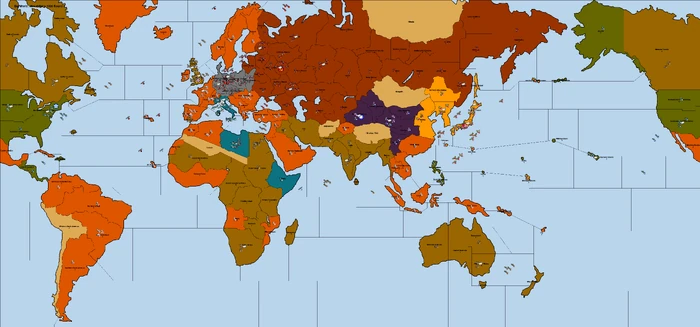Download: In repository under Big World Variations
This is a Triple-A variant of 1939 Pact of Steel Big World. It's a revision of the so called 'historical' game, (which is neither historical, nor 1939) Hill's old
Advanced fixed lame armour stats, carrier price, and channel access.
One big difference in this version is that industrial production centers now generate far more PUs as do strategically important zone
like Egypt's canal zone (8 PUs), Gibraltar(2 PUs), Sicily (4 PUs) and the oil fields of Rumania (7 PUs) and Saudi Arabia (8 PUs).
To lessen the impact of this economic generation, the price of factories is 25 PUs. (though it might arguably make sense to boost
that to 35 PUs). (if only there were a way to have separate resource (BRPs) and production (PUs) values for each territory! )
1)The game generally strengthens neutrals and makes zones like Turkey, Spain and Allied France more historically realistic. Hungary/
Rumania/Finland/Greece and other neutrals have challenging militaries and bigger resource (PU) holdings. Axis (and Soviet) military set
backs are now a possibility for poorly executed or just plain unlucky invasions.
2) The game generally makes Britain's hold on North Africa (Egypt) more economically critical and tenuous as was the case in the real
war. Places like Sicily are bumped up because of their strategic important in threatening this hold.
3) The U.S. is far more powerful at the offset economically than any other version I know, and sees that power snowball quickly leaving
the axis a pronounced window to rapidly grow its resource strength against Russia, England and european neutrals. The U.S. now has to
work if it wants to control South America, but there is no need because of its vast mainland PU reserve.
4) Italy is generally stronger, but balanced. Italy had the fourth largest fleet in WWII, bigger than the German surface fleet by far.
And Italy's poor military showing in the real war doesn't discount its strategic impact in tying down allied forces and supporting
Germany's push into southeastern Europe and Africa. However, her bark remains bigger than her bite unless she or Germany can land a lucky
strike against Egypt or Gibraltar. And rash early invasion of Greece or Southern France can potentially now cost Italy the game. Italy now
has enough transports to launch the Afrika Korps. and keeps its historical outpost in Ethiopia, threatening the south of the Suez
Canal zone.
5) Russia is also stronger, which gets rid of the illusion that England might have defeated Russia's vast armies alone, which of
course, isn't true. Russia starts off on roughly equal economic/ resource footing with Germany and can hold pace until the Axis
overruns Western Europe. It also starts with a fragile armoured presence in the Far East. Russia has a small Northern and Black Sea
Fleet for defense and possible counterstrike against an axis mistake.
6) Japan is weakened somewhat in relative terms. Japan's industrial capacity was not as overwhelming as some versions of Triple-A games
would make it seem. (I've seen a few where Japan takes Moscow! That's less likely due to a stronger Russian start in the Far East and U.S.
Flying Tigers in China).
7) Britain is about the same strength. But an effort was made to show her dependency on overseas outposts like India, Australia, Canada and
Africa which are highly vulnerable to the Axis and Japan. The United Kingdom's Island's defenses hung by a threat and were far weaker than
let's say France's mainland forces that were beaten by Germany in 1940. Eastern Canada, Southern Africa, India Egypt and Australia are
critical to a U.K. victory....
8) Germany is now much more resilient with vast PU production in East and West Germany. But unless Germany can expand rapidly, it will
face Russian forces of roughly equal capabilities, which was the case historically. Late game axis minor contributions from Hungary,
Finland, and Rumania are represented by generally higher PUs, though forces in these countries must still be defeated. (otherwise Russia
could grab them too easily). U Boat numbers are slightly upped to pose a real threat in the Atlantic.
9) China is largely unchanged. However Kansu is now stronger and has two U.S. Flying Tiger fighter airwings that may delay a rush by
Japanese forces.
10) More PUs mean more possibilities, but possibly more imbalances in playing. Let me know what you think of the map!
smevideo@mac.com
Nations: Germans Russians Italians British Japanese Chinese Americans
Units: infantry armour fighter bomber transport battleship carrier submarine factory aaGun artillery destroyer cruiser
